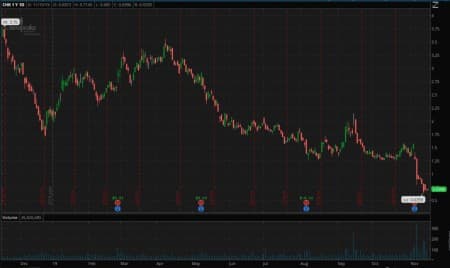Chesapeake Energy (CHK) has been a controversial stock for years. Its co-founder, Aubrey McLendon, who left the company in 2013, was indicted in 2016 for allegedly conspiring to fix lease prices in Oklahoma, then died in a fiery, single-vehicle car crash the next day. Even before that, allegations of impropriety surrounded McLendon, who reportedly used corporate funds for all manner of personal expenses. Even without the personality issues, Chesapeake attracts controversy as one of the early adopters of and leaders in hydraulic fracturing, or fracking.
Emotions about the company, and therefore the stock, run high. That has made the job of the current CEO, Doug Lawler, difficult, but it has also made it an attractive stock for traders. CHK is down a massive 81% over the last year, but along the way there have been several rapid bounces, making it an attractive two-way trade.
The latest big drop came last week, when Chesapeake included a “going concern” warning in their 10-Q quarterly earnings filing with the SEC. CHK reacted as if bankruptcy were imminent, collapsing over fifty percent in a week. That isn’t that much of a surprise. There have been worries about CHK’s ability to continue in the past, so any official mention of a possible problem will be seized on and, given the volatility of the stock, produce a massive reaction.
A calmer look at what was actually said and at the situation at CHK, however, suggests that reports of the death of Chesapeake Energy…
Chesapeake Energy (CHK) has been a controversial stock for years. Its co-founder, Aubrey McLendon, who left the company in 2013, was indicted in 2016 for allegedly conspiring to fix lease prices in Oklahoma, then died in a fiery, single-vehicle car crash the next day. Even before that, allegations of impropriety surrounded McLendon, who reportedly used corporate funds for all manner of personal expenses. Even without the personality issues, Chesapeake attracts controversy as one of the early adopters of and leaders in hydraulic fracturing, or fracking.
Emotions about the company, and therefore the stock, run high. That has made the job of the current CEO, Doug Lawler, difficult, but it has also made it an attractive stock for traders. CHK is down a massive 81% over the last year, but along the way there have been several rapid bounces, making it an attractive two-way trade.
The latest big drop came last week, when Chesapeake included a “going concern” warning in their 10-Q quarterly earnings filing with the SEC. CHK reacted as if bankruptcy were imminent, collapsing over fifty percent in a week. That isn’t that much of a surprise. There have been worries about CHK’s ability to continue in the past, so any official mention of a possible problem will be seized on and, given the volatility of the stock, produce a massive reaction.
A calmer look at what was actually said and at the situation at CHK, however, suggests that reports of the death of Chesapeake Energy may be a little premature.

Obviously, the kind of chart you see above doesn’t come about without there being real problems. The company has been reporting negative growth and losses for a while, and with a heavy debt load, traders were questioning its very survival. My question though would be, given that those doubts were already out there, did we actually learn anything new from last week’s 10-Q?
The answer, it seems, is no.
Any hint at bankruptcy is worrying, but if you look at the actual wording and context of the warning, it doesn’t say anything we didn’t already know. The relevant section is contained in the “Risk Factors” section of the report, which all companies file…there are always risks. It says…
“Further declines in oil, NGL and natural gas prices, or a prolonged period of low oil, NGL and natural gas prices could eventually result in our failing to meet one or more of the financial covenants under our credit facilities, which could require us to refinance or amend such obligations resulting in the payment of consent fees or higher interest rates, or require us to raise additional capital at an inopportune time or on terms not favorable to us”
And
“If depressed prices persist or decline throughout 2020, our ability to comply with the leverage ratio covenant under our revolving credit facility during the next 12 months will be adversely affected and may cause doubt about our ability to continue as a going concern.”
That’s a lot of ifs ands, maybes and mights. To put all that in simpler language, if everything goes wrong, we’ll be in trouble.
That, though, is more of an admission of reality than a revelation. It has been obvious for some time that things have to change for CHK to survive, the question traders should be asking is are they changing?
As far as what the company can control at least, it seems that they are.
Lawler has rightly pointed out that Chesapeake is in the process of rationalizing their operations, cutting costs considerably. In addition, there is no obvious near-term maturity approaching that would put the squeeze on, and the company has good liquidity. The CEO has also put his money where his mouth is, buying stock once the price sunk below $1.
There is no guarantee that, at some point, CHK won’t declare bankruptcy. The stock though is trading as if that is coming any day, and that looks extremely unlikely. So, now that a bottom has formed at around $0.65 and the dust has settled, buying on the basis that a bounce back will come looks like a decent high risk/high reward trade.


















